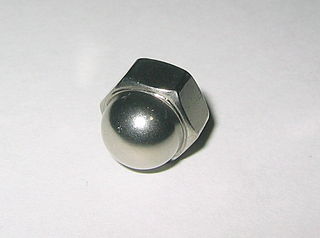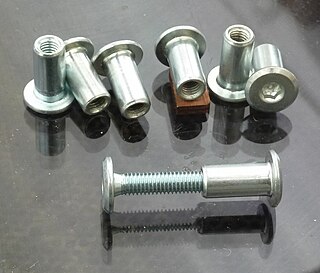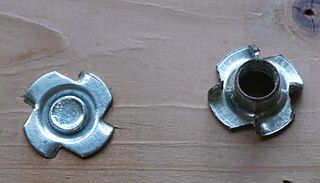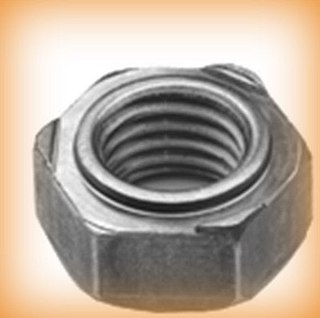
Bolted joints are one of the most common elements in construction and machine design. They consist of fasteners that capture and join other parts, and are secured with the mating of screw threads.

An acorn nut, also referred to as crown hex nut, blind nut, cap nut, domed cap nut, or dome nut (UK), is a nut that has a domed end on one side. When used together with a threaded fastener with an external male thread, the domed end encloses the external thread, either to protect the thread or to protect nearby objects from contact with the thread. In addition, the dome gives a more finished appearance.

A sex bolt,, is a type of fastener (nut) that has a barrel-shaped flange and protruding boss that is internally threaded. The boss sits within the components being fastened, the flange provides the bearing surface. The sex bolt and accompanying machine screw sit flush on either side of the surfaces being fastened. It is normally chosen because of its low profile compared to other nuts. The sex bolt often has a built-in feature, such as a slot, to aid in tightening the fastener. Some sex bolts, more commonly known as "architectural bolts", have knurled barrels to allow one-sided assembly. "Binding posts" are similar to architectural bolts in that they are designed to be assembled from one side, but they have teeth on the flanged surface to keep them fixed.

A nyloc nut, also referred to as a nylon-insert lock nut, polymer-insert lock nut, or elastic stop nut, is a kind of locknut with a nylon collar insert that resists turning.

A flange nut is a nut that has a wide flange at one end that acts as an integrated washer. This serves to distribute the pressure of the nut over the part being secured, reducing the chance of damage to the part and making it less likely to loosen as a result of an uneven fastening surface. These nuts are mostly hexagonal in shape and are made up of hardened steel and often coated with zinc.

A T-nut, T nut, or tee nut is a type of nut used to fasten a wood, particle or composite materials workpiece, leaving a flush surface.
A well nut is a type of fastener used to blindly fasten a piece and to seal the bolt hole. They are often referred to by the proprietary name Rawlnut or Rawl nut ;the name they are known by in the UK.
A split beam nut, also known as a split hex nut or slotted beam nut, is a locknut with slots cut in the top that separate the outside end into two or more sections that are bent slightly inward, making the thread diameter undersized in the slotted portion. As the nut is threaded on, these sections are forced back out to their original position and increase the friction between the nut and the fastener, creating the locking action.
A distorted thread locknut, is a type of locknut that uses a deformed section of thread to keep the nut from loosening from vibrations or rotation of the clamped item. They are broken down into four types: elliptical offset nuts, centerlock nuts, toplock nuts and partially depitched (Philidas) nuts.
A speed nut, aka sheet metal nut or Tinnerman nut, is a type of locknut with two sheet metal prongs that act as one thread. They are made from spring steel.

A weld nut is a special type of nut specifically designed to be welded to another object. There are various types for different applications.

A barrel nut is a specialized nut, and is commonly used in aerospace and ready-to-assemble furniture applications.

An internal wrenching nut,, is a cylindrical nut that is internally threaded on one side and has an Allen socket on the other side; the outside of the nut is smooth or has knurling on it.
A self-aligning nut, also known as a spherical nut or leveling nut, is a type of nut that is used in applications where the fastener is not perpendicular to the surface the nut anchors to. It achieves this action by using a flanged nut inside a specially shaped dished-out washer. They are commonly used in the aerospace industry. If this nut were not used the object would have to be spot faced perpendicular to the fastener.
A plate nut, also known as a nut plate, anchor nut or anchor plate, is a stamped sheet metal nut that is usually riveted to a workpiece. They have a long tube that is internally threaded and a plate with two clearance holes for rivets. The most popular versions have two lugs and they exist as fixed anchor nuts and as floating anchor nuts. The latter allows the nut to move slightly and so enlarges the positioning tolerances of the mounted parts. They were originally developed for the aerospace industry, but are now also common in automotive racing. These nuts are made up of variety of soft and hard materials. The choice of material depends on environment to which nut is subjected. Soft materials like copper or brass are used when nut is used in electrical application. Hard materials are used when nut is subjected to high stress environment. Sometimes stainless steel or nickel-plated nuts are used in order to increase corrosion resistance.

A screw is a type of fastener, in some ways similar to a bolt, typically made of metal, and characterized by a helical ridge, known as a male thread. Screws are used to fasten materials by digging in and wedging into a material when turned, while the thread cuts grooves in the fastened material that may help pull fastened materials together and prevent pull-out. There are many screws for a variety of materials; those commonly fastened by screws include wood, sheet metal, and plastic.

A bolt is a form of threaded fastener with an external male thread. Bolts are closely related to screws.

A square nut is a four-sided nut. Compared to standard hex nuts, square nuts have a greater surface in contact with the part being fastened, and therefore provide greater resistance to loosening. They are also much less likely to become rounded-off after repeated loosening/tightening cycles. Square nuts are typically mated with square-headed bolts. Square nuts are used along with flat washers in order to avoid damage from its sharp edges and helps to increase the strength of the fastener. Square nuts can have standard, fine or coarse threading with platings of zinc yellow, plain, zinc clear, tin and cadmium, among others. Most can meet either the ASTM A194, ASTM A563, or ASTM F594 standard.














